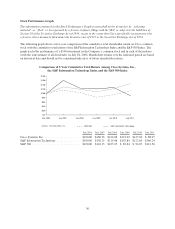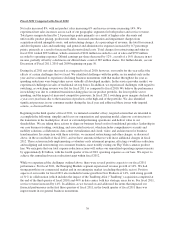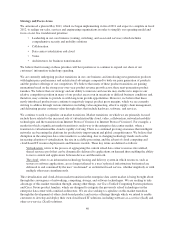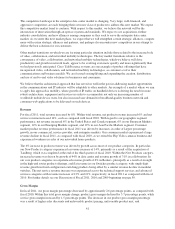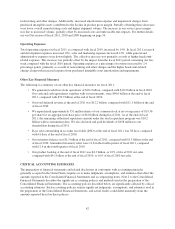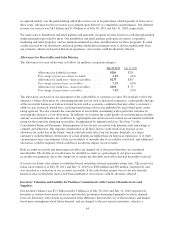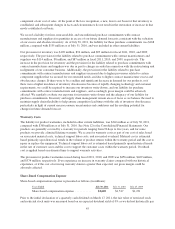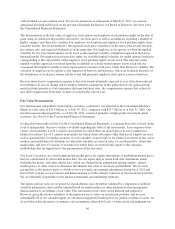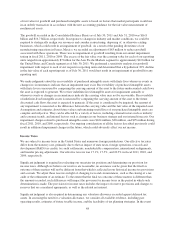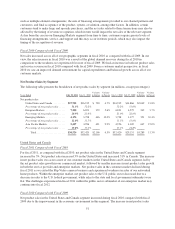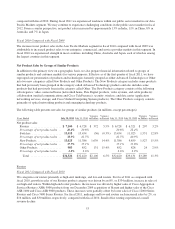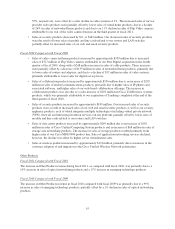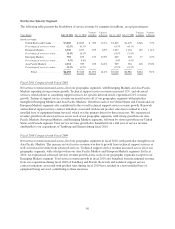Cisco 2011 Annual Report Download - page 54
Download and view the complete annual report
Please find page 54 of the 2011 Cisco annual report below. You can navigate through the pages in the report by either clicking on the pages listed below, or by using the keyword search tool below to find specific information within the annual report.cash dividends on our common stock. For awards granted on or subsequent to March 17, 2011, we used an
annualized dividend yield based on the per share dividends declared by our Board of Directors. See Note 14 to
the Consolidated Financial Statements.
The determination of the fair value of employee stock options and employee stock purchase rights on the date of
grant using an option-pricing model is affected by our stock price as well as assumptions regarding a number of
highly complex and subjective variables. For employee stock options and employee stock purchase rights, these
variables include, but are not limited to, the expected stock price volatility over the term of the awards, the risk-
free interest rate, and expected dividends as of the grant date. For employee stock options, we used the implied
volatility for two-year traded options on our stock as the expected volatility assumption required in the lattice-
binomial model. For employee stock purchase rights, we used the implied volatility for traded options (with lives
corresponding to the expected life of the employee stock purchase rights) on our stock. The selection of the
implied volatility approach was based upon the availability of actively traded options on our stock and our
assessment that implied volatility is more representative of future stock price trends than historical volatility. The
valuation of employee stock options is also impacted by kurtosis and skewness, which are technical measures of
the distribution of stock price returns and the actual and projected employee stock option exercise behaviors.
Because share-based compensation expense is based on awards ultimately expected to vest, it has been reduced
for forfeitures. If factors change and we employ different assumptions in the application of our option-pricing
model in future periods or if we experience different forfeiture rates, the compensation expense that is derived
may differ significantly from what we have recorded in the current year.
Fair Value Measurements
Our fixed income and publicly traded equity securities, collectively, are reflected in the Consolidated Balance
Sheets at a fair value of $36.9 billion as of July 30, 2011, compared with $35.3 billion as of July 31, 2010. Our
fixed income investment portfolio, as of July 30, 2011, consisted primarily of high quality investment-grade
securities. See Note 8 to the Consolidated Financial Statements.
As described more fully in Note 9 to the Consolidated Financial Statements, a valuation hierarchy is based on the
level of independent, objective evidence available regarding the value of the investments. It encompasses three
classes of investments: Level 1 consists of securities for which there are quoted prices in active markets for
identical securities; Level 2 consists of securities for which observable inputs other than Level 1 inputs are used,
such as quoted prices for similar securities in active markets or quoted prices for identical securities in less active
markets and model-derived valuations for which the variables are derived from, or corroborated by, observable
market data; and Level 3 consists of securities for which there are unobservable inputs to the valuation
methodology that are significant to the measurement of the fair value.
Our Level 2 securities are valued using quoted market prices for similar instruments or nonbinding market prices
that are corroborated by observable market data. We use inputs such as actual trade data, benchmark yields,
broker/dealer quotes, and other similar data, which are obtained from independent pricing vendors, quoted
market prices, or other sources to determine the ultimate fair value of our assets and liabilities. We use such
pricing data as the primary input, to which we have not made any material adjustments during fiscal 2011 and
fiscal 2010, to make our assessments and determinations as to the ultimate valuation of our investment portfolio.
We are ultimately responsible for the financial statements and underlying estimates.
The inputs and fair value are reviewed for reasonableness, may be further validated by comparison to publicly
available information, and could be adjusted based on market indices or other information that management
deems material to its estimate of fair value. The assessment of fair value can be difficult and subjective.
However, given the relative reliability of the inputs we use to value our investment portfolio, and because
substantially all of our valuation inputs are obtained using quoted market prices for similar or identical assets, we
do not believe that the nature of estimates and assumptions affected by levels of subjectivity and judgment was
46


